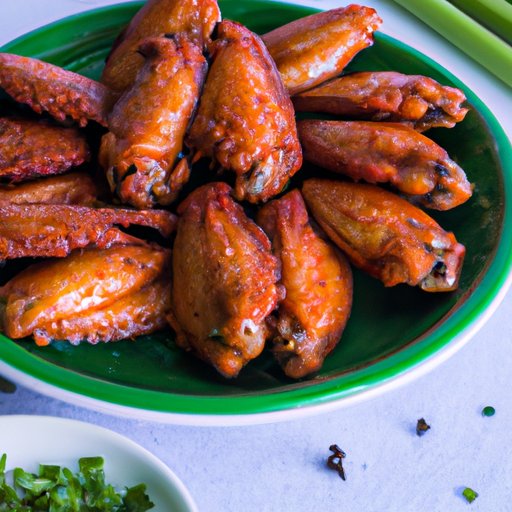
I. Introduction
If you’re a fan of wings, you know there’s nothing quite like biting into a crispy, juicy piece of perfectly fried chicken. Whether you’re hosting a party or simply craving some comfort food, frying chicken wings at home can be a delicious and satisfying experience. This article is aimed at food lovers of all skill levels who want to learn how to fry chicken wings at home. We’ll take you through each step of the process, from preparing the wings to choosing the right cooking method and pairing them with delicious sides.
II. Step-by-Step Recipe Guide
Before frying your chicken wings, it’s important to prepare them properly to ensure that they come out crispy and flavorful. Start by cleaning and trimming the wings, and then marinate them for at least an hour in your favorite spice mix or sauce. To create a crispy coating, you can use a mixture of flour, cornstarch, and baking powder. This will create a light, airy batter that will help the wings fry up golden and crispy.
When you’re ready to fry the wings, heat your oil to around 375°F in a heavy-duty pot or deep fryer. Work in small batches and fry the wings for 10-12 minutes, or until they’re cooked through and crispy. For an extra crispy coating, you can do a double fry. Remove the wings from the oil and let them drain on a paper towel-lined plate before serving.
To achieve the perfect crispy chicken wings, it’s important to follow some basic tips, such as drying the wings before frying and using a candy thermometer to monitor the oil temperature. You can also experiment with adding different spices or seasonings to the coating mix to create unique flavors.
III. Spice up Your Wings
While traditional buffalo or barbecue sauce is always a hit, there are plenty of other marinades and seasonings that can take your wings to the next level. For example, you could try a honey garlic sauce or a spicy Asian marinade. You could also experiment with dry rubs, such as a Cajun seasoning blend or a simple salt and black pepper mix.
One delicious marinade that pairs well with fried chicken wings is a combination of buttermilk and hot sauce. This tangy and spicy sauce will give your chicken wings a unique flavor that’s sure to please.
When preparing the different spice mixes and sauces, it’s important to remember that the flavors will intensify as they sit. So, it’s a good idea to taste as you go and adjust the seasoning accordingly.
IV. Safety Tips & Tools of the Trade
When it comes to frying chicken wings, safety should always be your top priority. Hot oil and frying equipment can be dangerous if not handled properly. To minimize the risk of injury, it’s important to use a heavy-duty pot or deep fryer with a lid, to avoid overcrowding the pot, and to have a fire extinguisher on hand just in case.
Once you’ve finished frying your chicken, it’s important to let the oil cool completely before straining it and storing it in a safe container. You should also make sure to clean your frying equipment thoroughly after each use.
Some essential tools for frying chicken wings include a heavy-duty pot or deep fryer, a candy thermometer to monitor the oil temperature, and a pair of tongs or a spider skimmer to remove the chicken from the oil. If you don’t have a deep fryer, you can use a Dutch oven or a cast-iron skillet instead.
V. Different Cooking Methods Compared
While deep-frying is one of the most popular methods for cooking chicken wings, it’s not the only option. Baking or air frying can also produce crispy and juicy wings, with less fat and fewer calories.
Baking chicken wings involves coating them in a mixture of flour and spices before baking them at 425°F for 40-50 minutes. The result is crispy wings that are healthier than deep-fried ones but still delicious.
Air frying is another option for those who want to reduce their oil intake. To air fry chicken wings, preheat the air fryer to 400°F, and cook the wings in batches for 12-15 minutes. The wings will come out crispy and delicious, with fewer calories and less fat.
While air frying and baking are great alternatives to deep-frying, they may not produce the same level of crispiness and flavor that you get from deep-frying. It’s important to experiment with different cooking methods and find the one that works best for you based on your taste preferences and dietary restrictions.
VI. Perfect Sides to Pair with Fried Chicken Wings
While chicken wings are tasty on their own, they can be made even more satisfying when paired with the right side dishes. Classic side dishes for wings include fries, coleslaw, and mac and cheese. Homemade ranch dressing or blue cheese dressing is always a hit with chicken wings too.
You could also take your sides up a notch and try something a little more unexpected, like grilled vegetables or a hearty salad. The key is to find something that complements the spicy or salty flavor of the wings without overwhelming it.
VII. Conclusion
Frying chicken wings at home can be both fun and delicious, but it’s important to approach it with the right tools and knowledge. By following the tips and techniques outlined in this article, you can create perfectly crispy and juicy wings that rival any restaurant. Whether you prefer traditional flavors or want to explore new marinades and seasonings, there’s a chicken wing recipe out there for everyone.




